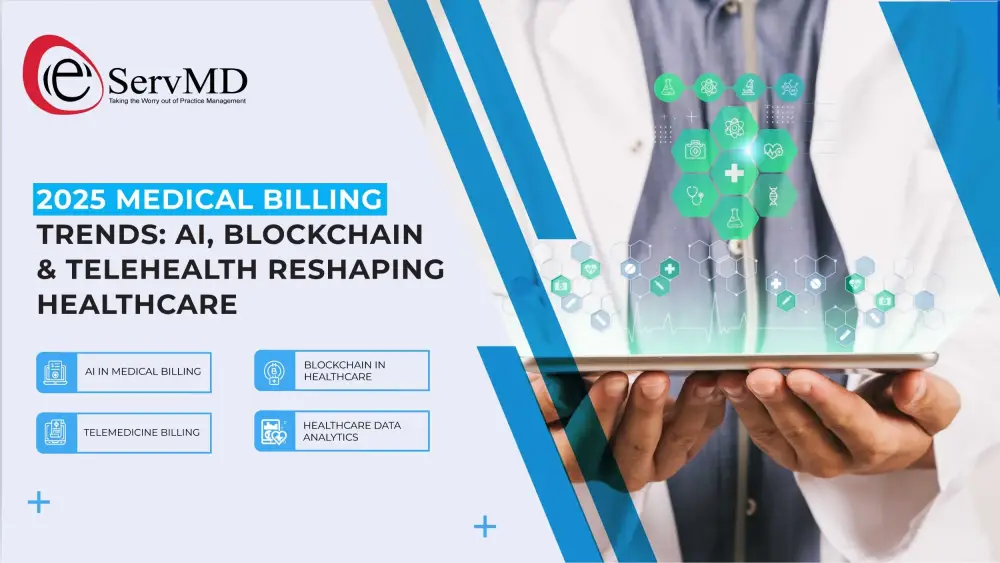
The medical billing industry is undergoing a radical transformation in 2025, fueled by innovations like AI-driven automation, blockchain security, and telemedicine billing. These 2025 medical billing tech trends are not just buzzwords they are reshaping how providers reduce denials, lower administrative costs, and improve patient payment experiences. For providers and medical billing companies, adopting these trends is critical to reduce patient AR, prevent healthcare fraud, and strengthen compliance. Here’s your comprehensive guide to staying ahead in this rapidly evolving landscape.
1. AI in Medical Billing 2025: Smarter, Faster Claims
Artificial Intelligence (AI) is revolutionizing workflows by:
-
Predictive Analytics: Identifying coding errors before submission.
-
Automated Denial Management: Resolving disputes 50% faster.
-
Smart Charge Capture: Reducing missed charges by 30%.
Result: 25% fewer A/R days and improved HIPAA compliance.
2. Blockchain in Healthcare: Unshakable Security
Blockchain technology is tackling billing fraud and data breaches through:
-
Immutable Records: Tamper-proof audit trails for CMS audits.
-
Smart Contracts: Auto-payments upon claim approval.
-
Decentralized Data: Securing PHI across EHR integration platforms.
Perfect for practices prioritizing healthcare fraud prevention.
3. Telemedicine Billing: Mastering Virtual Care
With telehealth booming, optimize telehealth billing with:
-
Location-Specific Modifiers (e.g., POS 02, 10).
-
Real-Time Eligibility Checks: Verify Medicaid eligibility during virtual visits.
-
Payer-Specific Rules: Adapt to evolving guidelines for remote services.
4. Robotic Process Automation (RPA) in Healthcare

RPA is slashing administrative burdens by:
-
Automating prior authorization workflows.
-
Streamlining payment posting with 99% accuracy.
-
Reducing manual data entry errors by 70%.
5. Patient-Centric Billing: Transparency Wins Trust

Modern patients demand clarity. Top tools include:
-
Self-Service Portals: View balances, set payment plans, and access healthcare data analytics.
-
Flexible Payment Options: Digital wallets, text-to-pay, and installment plans.
6. Healthcare Data Analytics: Smarter Decisions
Unlock insights like:
-
Denial Trends: Spot root causes (e.g., missing prior authorization).
-
Payer Performance: Track slow reimbursements from Medicare/Medicaid.
-
Patient Payment Behavior: Predict high-risk accounts early.
7. Compliance Management: Agility is Key
Stay ahead of 2024’s regulatory shifts with:
-
Automated Coding Updates: Sync EHR integration with latest ICD-11 codes.
-
AI Audits: Flag risks like upcoding or unbundling.
-
HIPAA Compliance Tools: Encrypt billing data end-to-end.
Why Partner with a Tech-First Medical Billing Company?
Leverage experts who specialize in:
-
AI in Medical Billing: Cut denials by 60%.
-
Blockchain Security: Protect against healthcare fraud.
-
Telemedicine Billing: Master modifiers like GT and 95.
-
RPA in Healthcare: Automate 80% of repetitive tasks.
Ready to Embrace 2025’s Tech Revolution?
Book a FREE Tech Audit to:
-
Integrate AI-driven tools into your workflow.
-
Secure data with blockchain technology.
-
Optimize telehealth billing for maximum reimbursements.
📞 Call Now: (954) 507-6242 | 🌐 Learn More: eservmd.com
FAQs — 2025 Medical Billing Tech Trends
Q1: What are the top 2025 medical billing tech trends providers should know?
The top 2025 medical billing tech trends include AI-driven automation for faster claims, blockchain technology for fraud prevention, telehealth billing solutions, robotic process automation (RPA) for prior authorization, and advanced healthcare data analytics. These innovations help providers reduce denials, improve revenue cycle performance, and deliver patient-centric billing experiences.
Q2: How is AI transforming medical billing workflows in 2025?
AI in medical billing is streamlining workflows by predicting coding errors, automating denial management, and enabling smart charge capture. In 2025, providers using AI tools are experiencing reduced A/R days, fewer denials, and improved compliance. This transformation helps practices reduce patient AR in medical billing and enhances efficiency across the entire revenue cycle.
Q3: Why is blockchain important for healthcare billing and fraud prevention?
Blockchain adds a layer of security and transparency to healthcare billing by creating tamper-proof audit trails, smart contracts, and decentralized patient data storage. In 2025, providers are leveraging blockchain to combat healthcare fraud and ensure accurate reimbursements. This technology builds trust and supports compliance during CMS audits and payer reviews.
Q4: What are the biggest challenges in telehealth billing in 2025?
The biggest challenges in telehealth billing solutions include adapting to evolving payer rules, using the correct location-specific modifiers (like POS 02 and 10), and verifying Medicaid or insurance eligibility in real time. Providers that integrate telehealth billing software and outsource to expert medical billing companies can overcome these issues effectively in 2025.
Q5: How can RPA improve revenue cycle management for medical billing companies?
Robotic Process Automation (RPA) improves revenue cycle management in medical billing by automating repetitive tasks like prior authorization, payment posting, and claims follow-ups. In 2025, RPA reduces manual errors by 70%, increases accuracy in payment reconciliation, and allows billing staff to focus on complex claim issues. This results in faster reimbursements and higher efficiency.
